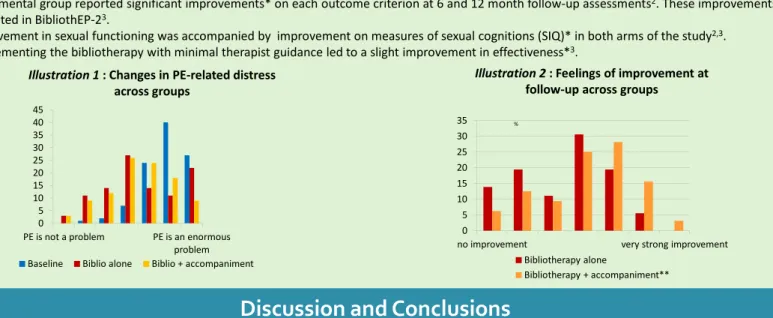The BibliothEP Study:
An evaluation of the clinical effectiveness of a bibliotherapy intervention for
premature ejaculation (PE)
Ph. Kempeneersa,b, R. Andriannec, S. Bauwensd, M. Cuddye, I. Georisd, Q. Longréea, J.F. Pairouxa(†), S. Blairya
aUniversité de Liège, Faculté de Psychologie (B). bClinique Psychiatrique des Alexiens, Henri-Chapelle (B). cUniversité de Liège, Faculté de Médecine - Urologie (B). dSexologues d’exercice libéral, Liège (B). eMaudsley Hospital, London (UK)*
Contact : p.kempeneers@ulg.ac.be
Introduction
Although premature ejaculation (PE) is a relatively common complaint, only a small proportion of men affected by it seek professional help. They are more likely to gather information about the problem and to attempt a number of self-help interventions themselves, often with limited success. Moreover, even for the small proportion of men who do seek specialist help for their problem, this often does not lead to a satisfying outcomes.
A number of factors may contribute to difficulty accessing treatments for PE. For example, some men feel uncomfortable talking about the issue, and there is a lack of awareness in the general population about effective treatments for PE. Furthermore, the treatments themselves have limitations: sex therapy can be a complex intervention and requires a specialist practitioner, and this form of treatment is rarely reimbursed by social security. This intervention requires substantial input on the patient’s part, often at significant financial cost, for results that are not guaranteed. On the other hand, pharmacological interventions can be effective in prolonging sexual intercouse, but delaying ejaculation is not the same as controlling it. Thus, sexual satisfaction is not always optimised, and the pharmacological agents can sometimes have undesirable side effects.
Objectives and methods
The BibliothEP study set it’s objective as improving the accessibility and effectiveness of first-line behavioural sex therapy interventions. The specific focus was on The BibliothEP study set it’s objective as improving the accessibility and effectiveness of first-line behavioural sex therapy interventions. The specific focus was on developing an intervention for PE that would be simple, effective, affordable and easy to access, safe, and possibly to use without professional guidance, or at least, without support from a specialist in sex therapy. A simplified behavioural sex therapy model of intervention was presented in a concise treatment manual (a bibliotherapy)1and offered as an intervention to a sample of volunteers reporting problems with PE. The bibliotherapy was offered either as a standalone intervention, or as an intervention supported by minimal guidance from a health professional not specialised in sex therapy.
The study was conducted in two phases: BibliothEP-12and BibliothEP-23
BibliothEP-1
BibliothEP-2
Participants:186 men affected by PE were randomly allocated to one of two groups. The experimental group (n = 120) received the bibliotherapy immediately, whereas the control group (n = 66) had a two-month wait.
Experimental design:participants were assessed at baseline, and then 6 and 12 months after receiving the bibliotherapy.
Outcome measures:self-reported ejaculatory latency time, feeling of control over ejaculation, sexual satisfaction, distress relating to the situation and feelings of improvement.
Participants:68 men affected by PE were randomly allocated to one of two groups. The control group (n = 36) received bibliotherapy alone, whereas the experimental group (n = 32) received bibliotherapy with minimal support from a therapist (45-90 minutes).
Experimental design: participants were assessed at baseline, and then 6 months after receiving the bibliotherapy.
Outcome measures:self-reported ejaculatory latency time, feeling of control over ejaculation, sexual satisfaction, distress relating to the situation and feelings of improvement.
Results
1. The effectiveness of bibliotherapy as a self-help treatment for PE was demonstrated in BibliothEP-1. Compared to the control group, participants in the experimental group reported significant improvements* on each outcome criterion at 6 and 12 month follow-up assessments2. These improvements were
replicated in BibliothEP-23.
2. Improvement in sexual functioning was accompanied by improvement on measures of sexual cognitions (SIQ)* in both arms of the study2,3.
3. Supplementing the bibliotherapy with minimal therapist guidance led to a slight improvement in effectiveness*3.
Illustration 1: Changes in PE-related distress
across groups 0 5 10 15 20 25 30 35 40 45
PE is not a problem PE is an enormous problem Baseline Biblio alone Biblio + accompaniment
0 5 10 15 20 25 30 35
no improvement very strong improvement Bibliotherapy alone
Bibliotherapy + accompaniment**
%
Illustration 2: Feelings of improvement at
follow-up across groups
Discussion and Conclusions
Bibliotherapy is an effective treatment for PE: it improves self-reported ejaculatory latency time, feeling of control over ejaculation, sexual satisfaction and PE-related distress. The addition of brief therapist support may enhance these treatment gains, although our study showed only modest benefits for guided bibliotherapy over bibliotherapy alone. The intervention appears to be slightly more effective when the PE is of moderate severity.
The cost-effectiveness of the bibliotherapy manual make it an ideal first-line treatment for PE.
Future research is needed to compare the relative effectiveness of bibliotherapy with pharmacotherapy and combined treatments.
www.bibliothep.be
1. Kempeneers, Bauwens & Andrianne . Lutter contre l’éjaculation précoce. De Boeck, 2015 2. Kempeneers et al. JSM, 9, 2419-28, 2012
3. Kempeneers et al., Submitted * t tests significant at p < .05
